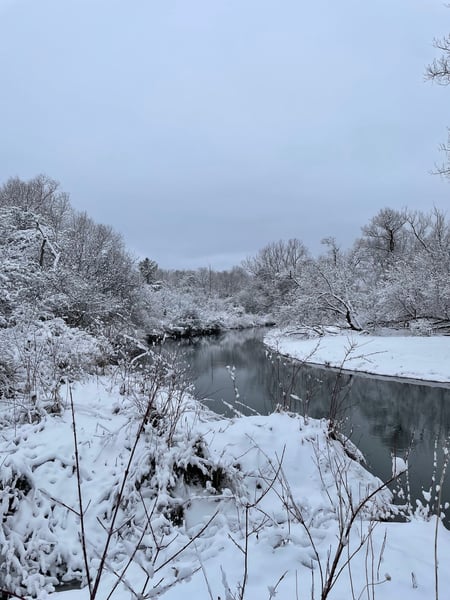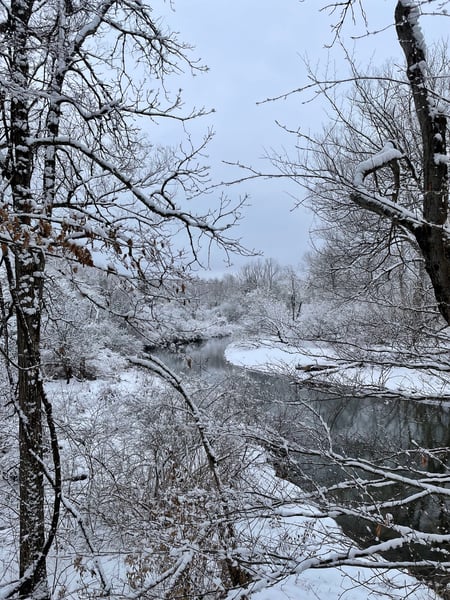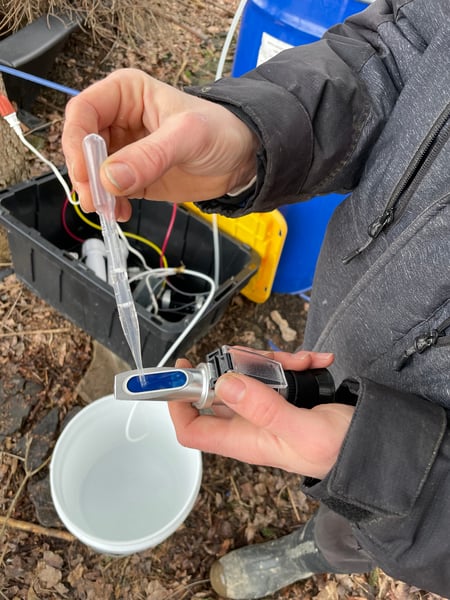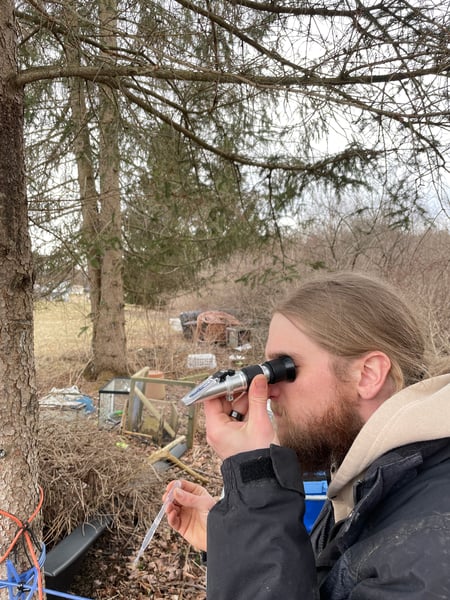
When last we spoke, my friend Derek and I had just finished running the lines for our sugar bush, and had just started collecting sap. Since then there have been a number of developments. A few days after we had done the initial tapping and line running, Derek called to tell me that he was having trouble with the system. Apparently the sap was running only very sporadically and there was a lot of air trapped in the lines. We made a plan to go back out and double check the integrity of the sugar bush that weekend.

The day I was to go over to troubleshoot the lines I woke up and noticed that it seemed very bright in the bedroom. I groggily stretched a hand over to the window and drew back the curtain just enough to peak out with one eye. A blanket of fresh snow had fallen overnight; crystals grown in morning’s beaker, as Pirate Prentice might say. Billions of tiny facets reflecting the early morning rays in every direction, illuminating the inside of our house with more light than it sees even in high summer. Though pretty, the snow could prove problematic for the task at hand.
After arriving at Derek’s place, we trudged out to the sugarbush to take stock of the situation. However, when we made it out to where the bulk of the sap lines were we discovered that we would not be doing any troubleshooting that day. The lines were frozen solid. We would have to wait until a warmer day to make sure everything was working properly. However the trip wasn’t all for naught because it was an arrestingly beautiful walk, and so quiet.
 We ended up spending a few hours putting together the plan for and ordering the reverse osmosis system (mentioned in the previous installment of the series), then called it a day.
We ended up spending a few hours putting together the plan for and ordering the reverse osmosis system (mentioned in the previous installment of the series), then called it a day.
A week later I went back, but in the intervening time Derek had successfully shored up the connections on all the sap lines, but was still getting interruptions in sap flow. He tried increasing the slope of the main line to pull a more compelling siphon as well but didn’t have much luck. Sap was still flowing, just not continuously, and sometimes it would have to be coaxed to resume its run. Eventually we figured out that the system was probably vacuum locked. The solution was a small pump that could continuously draw out the sap (there are other solutions that are, perhaps, more elegant, but the pump is simple, and it works).
Once the sap was flowing well thanks to the pump and a few warmer days it started building up fast. We knew we needed better storage than a handful of five gallon buckets. Derek was able to find on Craigslist a collection of 60 gallon drums that had previously been used for coconut cream. He was able to procure four of them and said they only slightly smelled of delicious coconut. But unfortunately coconut is not a flavor we are looking for in our maple syrup so a good cleaning was in order. Once the drums were ready for service he started dumping our five gallon collection bucket into them. After a few days, well, look for yourself.
That's 60 gallons, and there were a few more full five gallon buckets as well. We had to start processing the sap in some way. We didn’t have fuel yet for boiling (we have a wood fired evaporator), so in order to get the sap a little more compact and concentrated we started setting up the reverse osmosis system.
Very briefly, reverse osmosis (RO) is a system for filtering water such that is very pure, but without having to distill it. Typically you force the water through a membrane that more or less only lets water molecules through (if you did an osmosis lab with colored water and semi-permeable membrane sacks in high school biology, you pretty much get the idea). However, any method that returns very pure water will necessarily have to exhaust all the stuff that was filtered out. This can work to our benefit in maple syrup production because very pure water is exactly the thing we are trying to remove from our sap. In our case we would take what would normally be the ‘waste’, and that would be the sap that we boil into syrup. The RO water would just be a luxurious byproduct. Here’s what the system looks like.
The white bucket on top has our raw sap, which is then drawn down through the hose into the RO system in the black tote. You can see the pump which we use for filtering sap and drawing the sap through the lines (one of those at a time though unfortunately), as well as the two RO membrane units that we have connected in series (the sap goes through one, get concentrated, then the concentrated sap goes through a second membrane to concentrate even more (at least in theory)). What is dripping out at the very bottom is our final product before boiling.
Now we needed to use a refractometer to check the sugar concentration in the RO sap. These devices allow you to determine the ºbrix of whatever solution you put on the lens.

 Brix is a measurement of dissolved sugar, and basically corresponds to percent sugar in solution (50 ºbrix is a 50% sugar solution by weight). Finished maple syrup usually clocks in at around 65-70 ºbrix. Our RO sap was coming in at a tepid 4 ºbrix. This is likely due to the fact that basically zero of the maples we tapped were sugar maples. Sugar maple usually have sap that runs at around 3-5 ºbrix straight out of the tree. The maples we tapped (mostly red and silver maples) were issuing sap at around 1.5-2 ºbrix. Still this meant the RO was roughly doubling our syrup concentration which, though it doesn’t sound like much, would save us quite a lot of firewood. Speaking of which, this is just about all the progress we could make without firewood, so this is where we’ll pick back up next time for (what I sincerely hope is) the final installment of the sugarbush chronicles.
Brix is a measurement of dissolved sugar, and basically corresponds to percent sugar in solution (50 ºbrix is a 50% sugar solution by weight). Finished maple syrup usually clocks in at around 65-70 ºbrix. Our RO sap was coming in at a tepid 4 ºbrix. This is likely due to the fact that basically zero of the maples we tapped were sugar maples. Sugar maple usually have sap that runs at around 3-5 ºbrix straight out of the tree. The maples we tapped (mostly red and silver maples) were issuing sap at around 1.5-2 ºbrix. Still this meant the RO was roughly doubling our syrup concentration which, though it doesn’t sound like much, would save us quite a lot of firewood. Speaking of which, this is just about all the progress we could make without firewood, so this is where we’ll pick back up next time for (what I sincerely hope is) the final installment of the sugarbush chronicles.
If all this talk of imminent spring and sugar has you wanting to get in the sweet spirit with a little spring baking action, I recommend checking out our upcoming Spring Baking Workshop on Saturday, April 8 at 11am CST. Hope to see you there!

